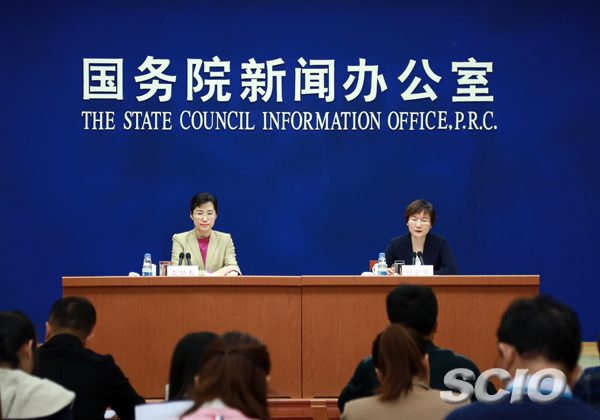China's economy slower but healthier
Fresh data has pointed to moderating but healthier growth in China's economy as structural reform reined in leverage and added impetus to new development momentum.
Investment, consumption and industrial output in October all posted slower growth than September, according to data released by the National Bureau of Statistics (NBS) Tuesday.
|
Liu Aihua (R), spokesperson of the National Bureau of Statistics, speaks at a press conference held by the State Council Information Office of China in Beijing, on Nov. 14, 2017. [Photo by Yuan Shaoda/China SCIO] |
However, the downshifts remained marginal, while robust job growth, the deleveraging progress and industrial upgrading continued to support a positive outlook for the economy.
"There is a solid foundation for the Chinese economy's mid- and long-term development," NBS spokesperson Liu Aihua said at a press conference, highlighting the improved quality rather than speed of growth.
"It is totally possible for the economy to maintain a stable and positive trend next year," Liu said.
Industrial value-added output expanded 6.2 percent year on year in October, slowing from a 6.6-percent growth in September. Retail sales of consumer goods grew 10 percent, down from 10.3 percent in September.
In the January-October period, fixed-asset investment grew 7.3 percent year on year, down 0.2 percentage points from the January-September level.
The fluctuation in October was "within a reasonable range," and some indicators were actually better than the same period of last year, said Liu.
Industrial output growth, for instance, was 0.1 percentage points faster than the growth of October 2016. Retail sales growth was flat with a year earlier.
"The October data point to a continued moderate slowdown, but not so far an alarming one," said Tom Orlik, Bloomberg chief Asia economist.
The economy is well on its way to hitting the annual GDP growth target of about 6.5 percent, with positive factors increasing, according to Liu.
Employment was stable. Nearly 12 million new jobs were created in cities during the January-October period, already exceeding the annual target of 11 million.
As of October, the surveyed unemployment rate in 31 major cities had been kept below 5 percent for eight months in a row.
Corporate leverage was down. Industrial firms above a designated size saw their combined debt ratio fall 0.6 percentage points year on year to 55.7 percent by the end of September.
The service sector continued to strengthen. In the first three quarters of the year, strategic emerging services posted a 17.5-percent revenue increase from a year earlier, while science and technology services climbed 14.6 percent.
Excess capacity has been cut by more than the target in the bloated steel and coal sectors, while advanced capacity steadily expanded its share.
High-tech industries and equipment manufacturing saw their output jump 13.4 percent and 11.5 percent year on year, respectively, in the January-October period, outpacing the overall industrial output growth.
China has made it a goal to shift to growth reliant more on innovation and technology, and less on debt-fueled, low-end investment.
Julia Wang, HSBC economist, said the manufacturing sector upgrade is continuing at a fast pace, a silver lining for China's slowing economy.
"Sustaining this positive trend will be key to sustaining China's growth in 2018 and beyond," Wang said in a research note.
Meanwhile, a weakening housing market may weigh further on growth in the short term, according to Wang, as both property investment and sales slowed in the first 10 months amid government policies to curb speculation.
China's GDP expanded 6.8 percent year on year in the third quarter, compared with 6.9 percent in the second quarter.
